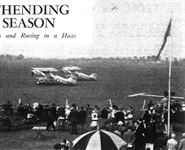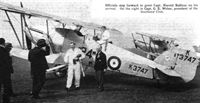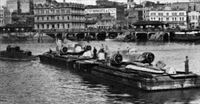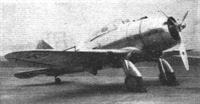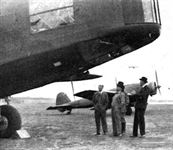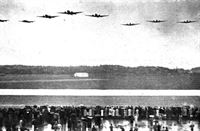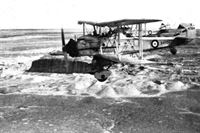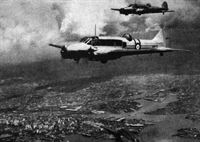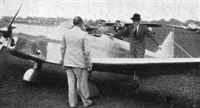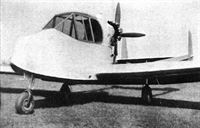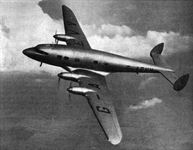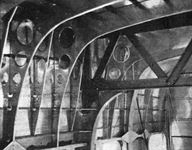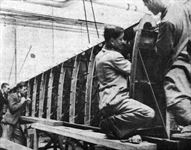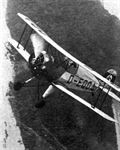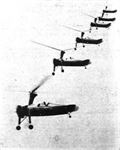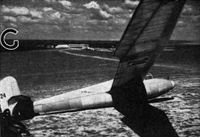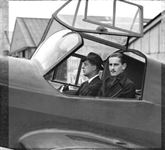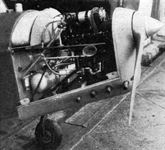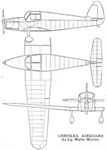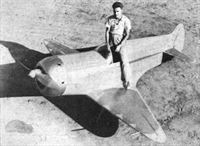Фотографии
-
MINISTERIAL INTEREST: Sir Kingsley Wood and Sir Edward T. Campbell inspect a Blenheim during a visit last week to the Bristol factory. The group includes Mr. H. J. Pollard (works manager), Mr. W. G. Verdon Smith (chairman), Mr. H. J. Thomas (assistant managing director), and Mr. W. A. Fernie (sales manager). This photograph, incidentally, gives an intimate view of the Blenheim’s nose and one of the 840 h.p. Mercury VIII engines.
Самолёты на фотографии: Bristol Blenheim - Великобритания - 1936
-
Mr. Leegstra, the pilot who recently made a Dutch altitude record of 37,250ft. with the Fokker D.21 (Bristol Mercury VIII).
Самолёты на фотографии: Fokker D.XXI - Нидерланды - 1936
-
The Fokker D.21 Single-seat Fighter Monoplane (Bristol "Mercury" engine).
Самолёты на фотографии: Fokker D.XXI - Нидерланды - 1936
-
Регистрационный номер: NC16008 THE STATUE OF LIBERTY appears to wave a greeting to an American Airlines Douglas DC3 as it flies past Bedloe's Island, outside New York Harbour. The famous figure is to have an extensive overhaul, inside and out, in preparation for the World’s Fair.
Самолёты на фотографии: Douglas DC-3 / C-47 Skytrain/С-53 Skytrooper / Dakota - США - 1935
-
THE AIR MINISTER, continuing his tour of aircraft factories and aerodromes, last week visited Hawkers and Vickers at Brooklands. He is seen here examining a Hawker Hurricane with (on left) Flt. Lt. P. W. S. Bulman (director and chief test pilot) and Mr. F. S. Spriggs (managing director).
Самолёты на фотографии: Hawker Hurricane - Великобритания - 1935
-
A bird's eye view of a small section of the member’s enclosure. In the haze, above the two Hart Trainers, can be seen the Percival Vega Gull, flown by Mr. D. M. Bay.
Самолёты на фотографии: Hawker Hart - Великобритания - 1928Percival Vega Gull / K.1 - Великобритания - 1935
-
Регистрационный номер: K3747 Officials step forward to greet Capt. Harold Balfour on his arrival. On the right is Capt. G. E. Weber, president of the Southend Club.
Самолёты на фотографии: Hawker Hart - Великобритания - 1928
-
As if by way of a salute, a flight of Gloster Gladiators from No. 74 Squadron (Hornchurch) thunder overhead on the arrival in two Hart Trainers of Capt. Balfour and Mr. Henry Channon, M.P. for Southend.
Самолёты на фотографии: Gloster Gladiator - Великобритания - 1934Hawker Hart - Великобритания - 1928
-
TRAINING THE TRAINER: Mr. H. W. C. Skinner, Philips and Powis test pilot, takes a turn with the Magister, now modified by the fitting of a rudder of higher aspect ratio.
Самолёты на фотографии: Miles Magister / M.14 - Великобритания - 1937
-
THE OXFORD BOAT: Airspeed Oxford twin-engined advanced trainers being shipped to the Royal New Zealand Air Force base at Hobsonville for assembly. They are the first of five ordered Thirty Vickers Wellingtons are scheduled for later delivery.
Самолёты на фотографии: Airspeed Oxford / AS.10 - Великобритания - 1937
-
Регистрационный номер: G-ADSR READY: Imperial Airways should very shortly be taking delivery of the first of the fourteen A.W. Ensigns, which appear to be well up on contracted performance and payload. This is a photograph of the first of the series taken on an early test flight.
Самолёты на фотографии: Armstrong Whitworth Ensign / A.W.27 - Великобритания - 1938
-
The cockpit: Throttle, mixture and v.p. control bank central, trimming wheels between seats, starter buttons in roof, fuel-cock controls on left.
Самолёты на фотографии: Armstrong Whitworth Ensign / A.W.27 - Великобритания - 1938
-
The all-white pantry, with ice-boxes, plate racks, etc. It also contains the cabin heater controls. It opens off the promenade deck.
Самолёты на фотографии: Armstrong Whitworth Ensign / A.W.27 - Великобритания - 1938
-
The promenade deck.
Самолёты на фотографии: Armstrong Whitworth Ensign / A.W.27 - Великобритания - 1938
-
Cabin warming equipment - by air steam - heated from exhaust muffs on inboard engines.
Самолёты на фотографии: Armstrong Whitworth Ensign / A.W.27 - Великобритания - 1938
-
The toilet compartment and the purser’s desk.
Самолёты на фотографии: Armstrong Whitworth Ensign / A.W.27 - Великобритания - 1938
-
THE first of the fourteen Ensign class liners are now about to go into service. Powered with four Siddeley Tiger IX engines (880 h.p. each for take-off) the Ensign is of 127 ft. span and carries 40 passengers in the “European” version or 27 by day and 20 by night in the “Empire” type. Left, is seen the centre cabin by day, with its adjustable chairs and tables, individual ventilators and lights, and windows at eye level. The colour scheme is a restful one of green and cream. Right, is a cabin partly converted. The seats are removed at the evening halt, and comfortable and roomy bunks substituted. There are four berths in the forward cabin, eight amidships, and eight aft.
Самолёты на фотографии: Armstrong Whitworth Ensign / A.W.27 - Великобритания - 1938
-
Самолёты на фотографии: Armstrong Whitworth Ensign / A.W.27 - Великобритания - 1938
-
Регистрационный номер: NR12222 Paul Mantz's Lockheed Orion is one of the few with a metal fuselage.
Самолёты на фотографии: Lockheed Orion 9 - США - 1931
-
Some of Sweden’s Gloster Gladiators come in over a line of F. W. Stieglitz trainers.
Самолёты на фотографии: Focke-Wulf FW.44 Steiglitz - Германия - 1932Gloster Gladiator - Великобритания - 1934
-
An unusual and striking formation put up by Seversky single-seater fighters of the 27th Pursuit Squadron, U.S. Army Air Corps, for a display at the National Air Races, Cleveland. The Seversky, with a Pratt and Whitney Twin Wasp of over 1,000 h.p., has a top speed of about 300 m.p.h. The gun-power is believed to be inferior to that of our own monoplane fighters.
Самолёты на фотографии: Seversky P-35 - США - 1936
-
The Seversky single-seater - the type which flew into first and second places. It is similar to a new standard pursuit machine of the U.S. Army Air Corps.
Самолёты на фотографии: Seversky P-35 - США - 1936
-
The Air Minister is seen under the imposing nose of a Wellington, with a Wellesley in the background. On the left is Sir Robert McLean, chairman of Vickers Aviation Ltd.
Самолёты на фотографии: Vickers Wellesley - Великобритания - 1935Vickers Wellington / Type 271 - Великобритания - 1936
-
Junkers Ju.86 bombers of the Swedish Air Force stage a fly-past.
Самолёты на фотографии: Junkers Ju.86 - Германия - 1934
-
The prototype Wirraway general-purpose machine, as now in production at Fishermen's Bend. It is built under licence from North American Aviation, Inc. The engine is a 550 h.p. geared Wasp.
Самолёты на фотографии: Commonwealth (CAC) CA-1 / CA-3 Wirraway - Австралия - 1939
-
Регистрационный номер: K4704 VICKERS VINCENT general-purpose machines on Middle East Service. These machines are essentially similar to the Vildebeest.
Самолёты на фотографии: Vickers Vincent / Type 266 - Великобритания - 1932
-
Westland Wapiti general-purpose machines (Bristol Jupiter) which are now being used exclusively for training.
Самолёты на фотографии: Westland Wapiti - Великобритания - 1927
-
Counterpart of our Westland Lysander, the North American O-47A three-seater observation (army co-operation) machine is now equipping units of American National Guard. With a Cyclone engine the machine has a top speed of 240 m.p.h. and a range of 1.000 miles. Two machine guns are carried. The observer’s compartment consists of an upper and lower section, the upper being devoted almost entirely to radio installations, with their controls, and a set of instruments. The seat folds down to form a head-rest for the lower, or photographic, compartment where a camera is mounted vertically over double doors in the bottom of the machine. Oblique photographs may be taken through observation windows on each side.
Самолёты на фотографии: North American O-47 - США - 1935
-
A Supermarine Seagull of the R.A.A.F. It is essentially similar to our Walrus, and is shown here with wheels down.
Самолёты на фотографии: Supermarine Walrus/Seagull V - Великобритания - 1933
-
A pair of Ansons from Richmond over the magnificent harbour at Sydney.
Самолёты на фотографии: Avro Anson / Type 652 - Великобритания - 1935
-
Ansons from Richmond Aerodrome over wooded country in the Blue Mountains.
Самолёты на фотографии: Avro Anson / Type 652 - Великобритания - 1935
-
Регистрационный номер: K6409, K6411, K6413 Трехместный Vildebeest Mk III стал основной серийной модификацией и в 1930-х годах был основным торпедоносцем-бомбардировщиком сухопутного базирования. На фотографии - самолеты из 42-й эскадрильи.
A flight of Vildebeests. Note the angle at which the torpedoes are carried.Самолёты на фотографии: Vickers Vildebeest / Type 132 - Великобритания - 1928
-
Регистрационный номер: K8084 Some pilots of No. 42 (T.B.) Squadron. Left to right: Sgt. N. B. Harvey, Sgt. F. D. Flinn, Sgt. G. S. Forbes, Sgt. G. S. Turner, P/O. G. S. P. Rooney, F/O. W. H. Cliff, F/O. J. S. Tupho'me. F/O. D. B. M. Wright, F/O. A. Hibberd, Sqn. Ldr. G. C. Bladon
Самолёты на фотографии: Vickers Vildebeest / Type 132 - Великобритания - 1928
-
Torpedo attack on a ship: Two Vildebeests have levelled out and are aiming at the vessel, while a third is still diving down from the height at which the approach was made.
Самолёты на фотографии: Vickers Vildebeest / Type 132 - Великобритания - 1928
-
This striking photograph shows No. 42 (T.B.) Squadron in formation over one of the inlets of the South Coast. This is the only squadron equipped with the Vickers Vildebeest IV driven by the Bristol sleeve-valve Perseus engine.
Самолёты на фотографии: Vickers Vildebeest / Type 132 - Великобритания - 1928
-
Not a ghost squadron: Our photographer has caught the formation at a moment when some trick of light on a dull day shows the machines up vividly against the ground. Their usual duties, however, take them over the sea where their silvery paint would not make them so conspicuous.
Самолёты на фотографии: Vickers Vildebeest / Type 132 - Великобритания - 1928
-
Fixing the "tin fishes." The levers on the trolley raise the torpedo into the carriers under the Vildebeest.
Самолёты на фотографии: Vickers Vildebeest / Type 132 - Великобритания - 1928
-
Самолёты на фотографии: De Havilland Dragon Rapide / Dominie / D.H.89 - Великобритания - 1934
-
Capt. Balfour appears to adopt a menacing attitude towards a seemingly apprehensive Brian Allen; but he is merely inspecting the two-seater Tipsy.
Самолёты на фотографии: Tipsy B / BC - Бельгия - 1937
-
Регистрационный номер: G-AFGB The Arpin pusher on which the experiments are being carried out with an undercarriage which is directionally adjustable on the ground. In actual practice the degree of “crab” will be adjustable from the pilot’s seat
Самолёты на фотографии: Arpin A-1 - Великобритания - 1938
-
Регистрационный номер: G-ADHV IRAQ STUDIES BRITISH TRAINING METHODS: Capt. Madhat Abduk Rahman, chief instructor of the Iraq Air Force Training School, is over here to study typical R.A.F. Reserve and Volunteer Reserve organisation. He is here seen with Flt. Lt. C. A. Pike, at the De Havilland School of Flying at Hatfield, where, incidentally, he conducted the acceptance trials of three new D.H.89S for Iraq
Самолёты на фотографии: De Havilland Tiger Moth / D.H.82 - Великобритания - 1931
-
Mr. HORE-BELISHA, the War Minister, visiting the Anti-Aircraft Practice Camp at Watchet, where he saw the 61st Anti-Aircraft (Territorial) Battery shooting at a Queen Bee.
Самолёты на фотографии: De Havilland Queen Bee / D.H.82B - Великобритания - 1935
-
AFTER DARK: An impressive night picture of the Jersey Airport building with one of Jersey Airways' D.H.86s in the foreground. Last month this company carried 8,015 passengers in and out of the airport
Самолёты на фотографии: De Havilland Express Air Liner / D.H.86 - Великобритания - 1934
-
A Union Airways D.H.86 on the daily Palmerston-Blenheim-Christchurch-Dunedin run.
Самолёты на фотографии: De Havilland Express Air Liner / D.H.86 - Великобритания - 1934
-
Some well-known pilots on the Dominion's airlines (left to right): Cdr. S. Gilkison Cook Strait Airways; 2nd Officer G Harvey and Cdr A G Gerrand service manager and chief pilot of Union Airways; and 2nd Officer W. G. C. Allison and Cdr. R. A. Kirkup of Union Airway
Самолёты на фотографии: De Havilland Express Air Liner / D.H.86 - Великобритания - 1934
-
Регистрационный номер: G-AEVV SUITABLY STRENGTHENED: The second D.H. Albatross long-range monoplane is now flying, having been reinforced at the point in the fuselage which was found to be weak. All the passenger machines will be similarly strengthened. The reinforcement weighs only 12.5 lb.
Самолёты на фотографии: De Havilland Albatross / D.H.91 - Великобритания - 1937
-
The fuselage of the D.H.95 is of stressed-skin construction. The nose, with flying controls, etc., is a separate unit. The gills of the controlled cooling system are placed much farther aft of the Bristol Perseus engines than usual.
Самолёты на фотографии: De Havilland Flamingo / D.H.95 - Великобритания - 1938
-
The tail of the D.H.95 is a pure cantilever, and the elevator is carried on set-back hinges. The rudders are bolted to the outer ends of the tailplane.
Самолёты на фотографии: De Havilland Flamingo / D.H.95 - Великобритания - 1938
-
The attachment of the main and auxiliary wing spars, which pass through the fuselage. The centre-section of the wing can be removed by undoing a few bolts.
Самолёты на фотографии: De Havilland Flamingo / D.H.95 - Великобритания - 1938
-
The outer wing portion, shown in the photograph, has a single spar and stressed-skin torsion box. The notches in the wing ribs are for the extruded stringers of the skin.
Самолёты на фотографии: De Havilland Flamingo / D.H.95 - Великобритания - 1938
-
Регистрационный номер: A1-49 An Australian Demon general-purpose machine with Rolls-Royce Kestrel V engine.
Самолёты на фотографии: Hawker Demon - Великобритания - 1932
-
Through the hangar doors at Richmond, the largest station of the R.A.A.F. The Blue Mountains are seen in the distance.
Самолёты на фотографии: Hawker Demon - Великобритания - 1932
-
Регистрационный номер: G-AESV The Heston Phoenix used by Standard Radio has a D.H. controllable pitch airscrew. The small size of the streamlined loop enclosure is noteworthy.
Самолёты на фотографии: Heston Phoenix - Великобритания - 1935
-
The loop-setting control and its beating dial as they appear in the roof of the Phoenix. The outer ring of the dial is separately rotatable and can be moved to set the machine’s compass bearing so that, from the moving cursor, the magnetic bearing of any particular station may be directly read off. In the centre of the dial there is a quadrantal error curve, so that the amount of this error can be seen for any particular bearing shown by the cursor.
Самолёты на фотографии: Heston Phoenix - Великобритания - 1935
-
Some of the special equipment which may be carried against the rear bulkhead of the Phoenix. On the left is the normal medium-wave transmitter and receiver, while on the right is the radio compass receiver with its two indicator units. Its place is normally taken by the ultra-short-wave blind-approach receiver. Just at present an improved version of the compass is being developed.
Самолёты на фотографии: Heston Phoenix - Великобритания - 1935
-
The dashboard of the Phoenix carries, on the left, normal blind-flying instruments as well as homing and blind-approach indicators, while on the right is the built-in D/F receiver. Below the latter and out of sight behind the right-hand wheel is the control gate for the short-wave fighter set.
Самолёты на фотографии: Heston Phoenix - Великобритания - 1935
-
Регистрационный номер: G-AEST MOSSCRAFT’S LATEST PRODUCT being demonstration-flown at Hanworth by Mr. W. H. Moss, one of the five Moss brothers who, incidentally, are all pilots. It is an open tandem-two-seater sports model powered by a Pobjoy Niagara III. Mechanically operated split flaps are fitted. Dual control is a feature which makes the Mosscraft suitable for C.A.G. purposes. Top speed is 134 m.p.h., cruising 115 m.p.h. and landing 38 m.p.h.
Самолёты на фотографии: Mosscraft MA-1 / MA-2 - Великобритания - 1937
-
Flt, Lt. H. J. Wilson was second at 145.1 m.p.h. in a Percival Gull
Самолёты на фотографии: Percival Gull - Великобритания - 1932
-
Регистрационный номер: G-AEUA Tiberias, on the Sea of Galilee, seemingly quiet, but a centre of the present troubles.
Самолёты на фотографии: Short Empire / S.23 - Великобритания - 1936
-
Dabai, a refuelling halt on the Persian Gulf. The rest-house is in the form of a fort ten miles away, at Sharjah.
Самолёты на фотографии: Short Empire / S.23 - Великобритания - 1936
-
Singapore, with its £210,000 base for landplanes and flying boats. It has a fine slipway and extensive servicing facilities.
Самолёты на фотографии: Short Empire / S.23 - Великобритания - 1936
-
Самолёты на фотографии: Short Empire / S.23 - Великобритания - 1936
-
Off into the sunrise: The early rising day after day is not really so bad. After take-off, passengers usually have a sleep before breakfast.
Самолёты на фотографии: Short Empire / S.23 - Великобритания - 1936
-
Самолёты на фотографии: Short Empire / S.23 - Великобритания - 1936
-
Регистрационный номер: G-ADNO [2] F/O. Geoffrey de Havilland and the T.K.2 in which he won at 187.5 m.p.h. from scratch.
Самолёты на фотографии: De Havilland Technical School T.K.2 - Великобритания - 1935
-
Регистрационный номер: G-ADNO [2] F/O. Geoffrey de Havilland and the T.K.2 (seen taking off from Heston at the start) in which he won at 187.5 m.p.h. from scratch. This is the T.K.2’s third Cardiff Race win.
Самолёты на фотографии: De Havilland Technical School T.K.2 - Великобритания - 1935
-
Регистрационный номер: D-EQOA JUNGMEISTERFUL AEROBATICS: A Bucker test pilot, Arthur Benitz, has been touring South America with a Jungmeister and a Jungmann, and has given some 85 demonstrations. This lively aerial impression may be regarded from almost any angle.
Самолёты на фотографии: Bucker Bu.133 Jungmeister - Германия - 1935
-
Designed expressly for the North Atlantic service, the latest four-engined Dornier flying boat, the gull-winged Do. 26, incorporates many unusual features. Lateral sponsons, characteristic of Dornier boats, have been replaced by retractable wing floats.
Самолёты на фотографии: Dornier Do.26 - Германия - 1938
-
On the Dornier Do.26 the engineer sits aft, in front of a comprehensive instrument panel, thereby relieving the pilots of a good deal of instrument-watching and engine control adjustment. The engineer has access to all four engines.
Самолёты на фотографии: Dornier Do.26 - Германия - 1938
-
Max Constant’s special Beechcraft.
Самолёты на фотографии: Beechcraft Model 17 Staggerwing - США - 1932
-
Регистрационный номер: NX18601 [2] OUT AGAIN: The big Boeing flying boat designed for the Atlantic service is now out again for tests with its redesigned tail unit. It will be remembered that during the initial tests the directional surfaces were found to be inadequate. Presumably the sponsons have also been modified, since the machine’s stability in the water was not a strong point during taxying trials.
Самолёты на фотографии: Boeing Boeing 314 Clipper - США - 1938
-
Регистрационный номер: NX18601 [2] ON TEST AGAIN: The Boeing 314 Atlantic boat flying over Seattle on test with its new twin-rudder tail assembly and modified sponsons. In this case she was loaded up to a gross weight of 77,500 lb., which is stated to be the greatest ever to be airborne over America. Included in the weight was the test pilot, Edmund T. Allen, with a crew of five assistants and test engineers.
Самолёты на фотографии: Boeing Boeing 314 Clipper - США - 1938
-
Регистрационный номер: NX18100 The Douglas DC4 has now made its initial test flights and it is seen coming in to land at Santa Monica.
Typical of the kind of machine for which the Maclaren undercarriage is intended. The new Douglas D.C.4, which already has a tricycle landing gear and is the largest machine so fitted - a very courageous experiment in itself.Самолёты на фотографии: Douglas DC-4E - США - 1938
-
AMERICAN ARMY AUTOGIROS adopt one of the most difficult formations in the book - echelon stepped up.
Самолёты на фотографии: Kellett KD-1 / YG-1 - США - 1934
-
Регистрационный номер: VH-UXH A Lockheed Electra 10A of Guinea Airways in the vicinity of Flemington Racecourse.
Самолёты на фотографии: Lockheed Electra 10 - США - 1934
-
Регистрационный номер: G-AFGN [2] NON-STOP "FOURTEEN": British Airways’ Lockheed 14, which flew from Heston to Stockholm and back last Sunday, having made the 905-mile journey non-stop each way. On the outward trip she averaged 212 m.p.h.
Самолёты на фотографии: Lockheed Super Electra 14 - США - 1937
-
Регистрационный номер: G-AFGN [2] ONE OF FOUR: Airwork and general interest in British Airways' first Lockheed 14, which was flown up to Heston from Southampton, where it was assembled, last Saturday. The cleanliness of the Hamilton hydromatic airscrew hubs is noteworthy. The British Airways’ 14s have several non-standard features.
Самолёты на фотографии: Lockheed Super Electra 14 - США - 1937
-
A Wasp Junior-powered Spartan Executive flown by Charles La Jotte. There is an auxiliary tank behind the cabin.
Самолёты на фотографии: Spartan 7W Executive - США - 1936
-
The Cyclone-engined Northrop Gamma of Bernarr MacFadden. This machine, with Conqueror engine, was entered for the MacRobertson Race but came to grief.
Самолёты на фотографии: Northrop Gamma / A-13 / A-16 - США - 1932
-
This painting of A.A. crews in action is typical of the virile work of an American artist, Alfred Owles, who recently held an exhibition of his aviation pictures in Los Angeles. He formerly lived in England, and served as a pilot in the U.S. Photographic Corps during the war. The aircraft in the painting are Curtiss Shrikes.
Самолёты на фотографии: Curtiss A-8 / A-12 Shrike - США - 1931
-
The layout of the wing-struts, undercarriage, cabin and quickly detachable cowling, is shown in this photograph of the Chief. There is a door on each side of the cabin.
Самолёты на фотографии: Aeronca K Scout / KM Chief - США - 1937
-
Самолёты на фотографии: Aeronca K Scout / KM Chief - США - 1937
-
The control layout of the new Aeronca is unconventional though interesting by English standards. There are three major instruments, one covering engine performances (including an oil-temperature gauge), and two others for airspeed and altitude. There is a primer on the left - a useful and unusual feature in small aeroplanes.
Самолёты на фотографии: Aeronca K Scout / KM Chief - США - 1937
-
Самолёты на фотографии: Goppingen Go.3 Minimoa - Германия - 1935
-
AIR MARSHAL SIR PHILIP JOUBERT DE LA FERTE (Air Officer Commanding, R.A.F., India) and F/O King on the occasion of the Air Marshal’s visit to the Airspeed works to take delivery of the first of two Envoys for India
Самолёты на фотографии: Airspeed Envoy / AS.6 - Великобритания - 1934
-
Регистрационный номер: VH-UXM Ansett Airway’s Airspeed Envoy (Wolseley Aries) over Melbourne, with the Shrine of Remembrance (which is quite near the Air Board H.Q.) in the background, and Government House to the left. This machine was originally owned by Lord Nuffield and was flown by Sqn. Ldr. Hilton from Capetown to Croydon in fast time.
Самолёты на фотографии: Airspeed Envoy / AS.6 - Великобритания - 1934
-
Регистрационный номер: ZK-ADI Air Travel are still receiving faithful service from their Fox Moths. The one seen here is about to load whitebait caught in the rivers of Westland.
Самолёты на фотографии: De Havilland Fox Moth / D.H.83 - Великобритания - 1932
-
Our old friend the Q.E.D. which kept everyone on tenterhooks at Mildenhall in 1934. The engine is a Pratt and Whitney Hornet. This machine was flown in the Bendix event by George Armistead.
Самолёты на фотографии: Gee Bee QED - США - 1934
-
THE DANISH KZII in the air near Copenhagen. This machine is fitted with a Cirrus Minor engine and has a cruising speed of 110 m.p.h. In general layout it is rather similar to a scaled-down Monarch, though the fuselage in this case is of welded steel-tubing. The KZII is the first result of serious internal design and production of aircraft in Denmark.
Cirrus Minor engines have found their way to many distant lands; The Danish Kramme and Zeuthens’ K-Z.II has a welded steel fuselage and folding wooden wings.Самолёты на фотографии: SAI KZ.II - Дания - 1937
-
DAGGER-POWERED: The prototype of the Hereford bomber (two Napier Dagger VIII), now in production in the Short and Harland factory at Belfast, made an appearance last week-end. The machine shown actually started life as a Hampden with Bristol Pegasus engines and was built in the Handley Page works. Production machines are likely to have a modified nose.
Самолёты на фотографии: Handley Page Hereford / H.P.53 - Великобритания - 1937
-
The tricycle Drone mentioned by Mr. Dimock in his letter.
Самолёты на фотографии: Kronfeld Drone - Великобритания - 1932
-
Регистрационный номер: F-NORD STILL THE "LIEUTENANT: On Tuesday of last week the veteran Latecoere flying boat left Biscarosse, where it is seen in this photograph, for Lisbon, the Azores and New York. The flight is being made easily and with the sole object of studying the North Atlantic route. The machine's new registration markings are interesting.
Самолёты на фотографии: Latecoere Late 521 / 522 / 523 - Франция - 1935
-
THE NEW VEGA: A drawing of the first production machine to be fitted with the Unitwin engine as it should appear when it is completed early next year. The power unit is made up of two 260 h.p. Menascos and the machine will carry five or six people.
Самолёты на фотографии: Lockheed Vega Starliner - США - 1939
-
A Stinson Model A trimotor of Airlines of Australia refuelling at Archerfield Aerodrome, Brisbane, after a night flight
Самолёты на фотографии: Stinson Model A - США - 1934
-
Регистрационный номер: G-AFIN [3] Test pilot Frank Dawson Paul (nearest camera) and Chrislea co-founder Richard Christoforides demonstrate the roomy cabin of the Airguard at Heston in September 1938. Presumably this may have been the closest the latter got to experiencing the aircraft in its element, as he suffered from a fear of flying. Note how in the construction of the cockpit the two top fuselage longerons were carried on and “broken” to drop several inches to enhance the view from the cockpit, a primary aim of the design.
Самолёты на фотографии: Chrislea L.C.1 Airguard - Великобритания - 1938
-
Регистрационный номер: G-AFIN [3] By means of ply-covered balsa, the fuselage is faired off to the extremity of the rudder.
Самолёты на фотографии: Chrislea L.C.1 Airguard - Великобритания - 1938
-
Регистрационный номер: G-AFIN [3] A fully braced mounting is provided for the Waiter Mikron engine. Normal crankcase stresses are avoided.
Самолёты на фотографии: Chrislea L.C.1 Airguard - Великобритания - 1938
-
Chrislea Airguard (62 h.p. Walter Mikron)
Самолёты на фотографии: Chrislea L.C.1 Airguard - Великобритания - 1938
-
SEPTEMBER MORN: The first day of Air Guard instruction gave the news photographcs their opportunity, and the improbability of the poses was only equalled by the futility of the captions. Here, however, is one of the more pleasing efforts, showing Mr. John Kirwan (right) in action with two recruits at Hanworth.
Самолёты на фотографии: De Havilland Gipsy Moth / Moth X - Великобритания - 1928
-
LOGICAL UNCONVENTIONALITY? The De Bruyne-Maas Ladybird, which has been used at Cambridge for the purpose of trying out a number of ingenious ideas. It will be seen that the machine is a shoulder-wing monoplane with a tricycle undercarriage, and the design incorporates various interesting items of what may be termed near-bakelite construction. The trailing edge of each of the main undercarriage trousers can be turned to provide air-braking surface. Mr. R. G. Doig carried out the initial test-flying both wit h the original Scott engine and with the Bristol Cherub with which the machine is now fitted.
Самолёты на фотографии: De Bruyne-Maas Ladybird - Великобритания - 1937
-
Регистрационный номер: NX479W A THIRTEEN-FOOTER: This alarming little biplane has been built (needless to say in America) by Mr. Vincent Linberg in his spare time. On its test flights - made by Mr. James Malone, seen in the cockpit - it did 170 m.p.h., but would appear to be capable of higher speeds.
Самолёты на фотографии: Linburg Special - США - 1938
-
- AND ANOTHER: The estimated maximum speed of this little Pobjoy-engined monoplane, likewise with a span of thirteen feet, is 235 m.p.h. It has been christened the San Diego Flagship, and was built for participation in the National Air Races at Cleveland.
Самолёты на фотографии: Flagg F-15 San Diego Flagship - США - 1937
Статьи
- Flight
- Flight Advertisements





